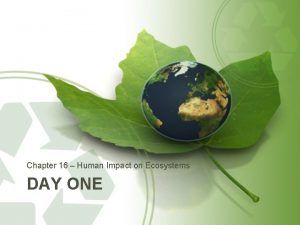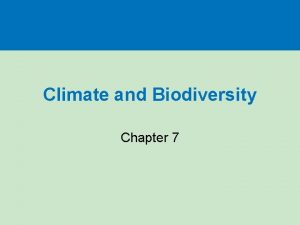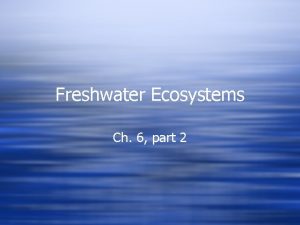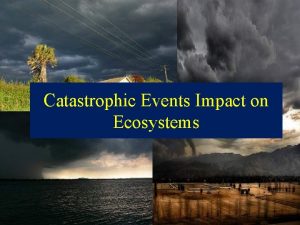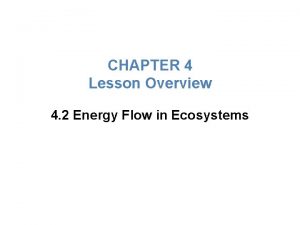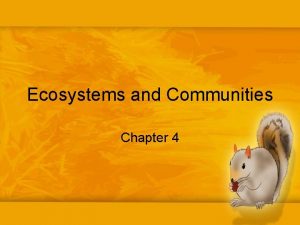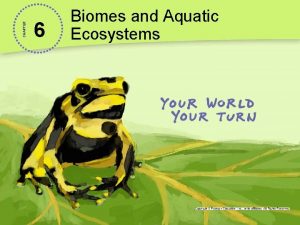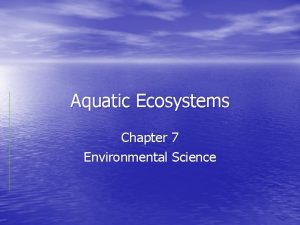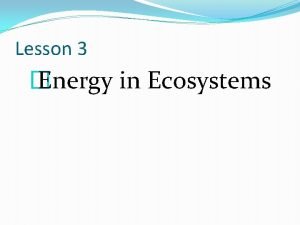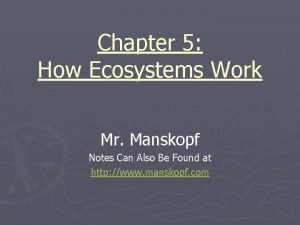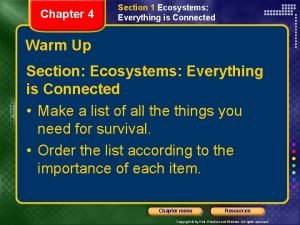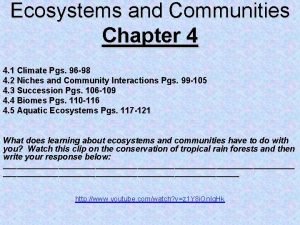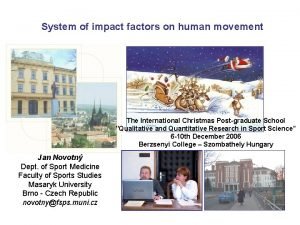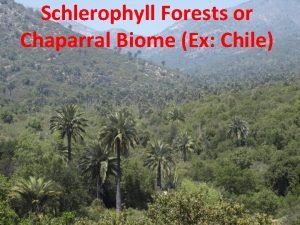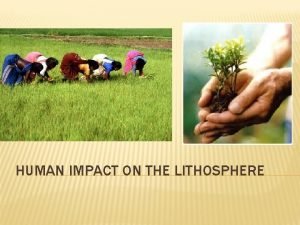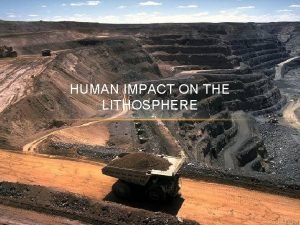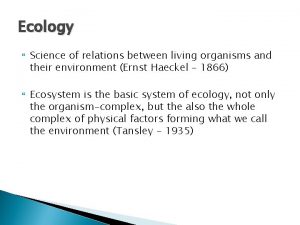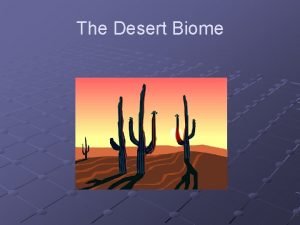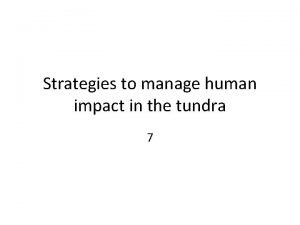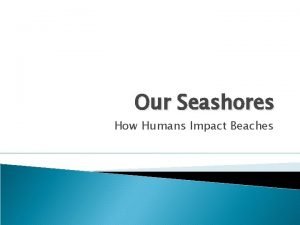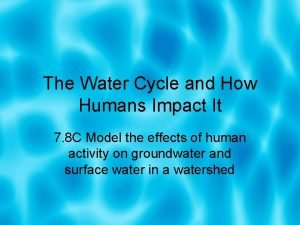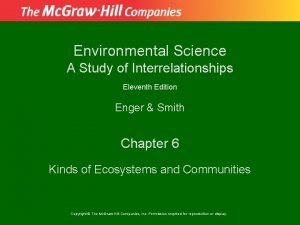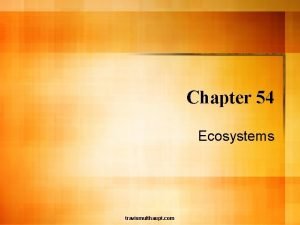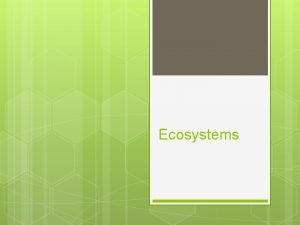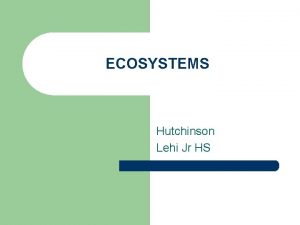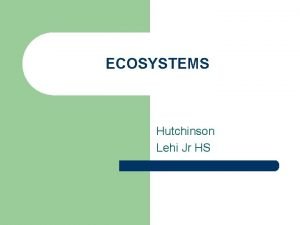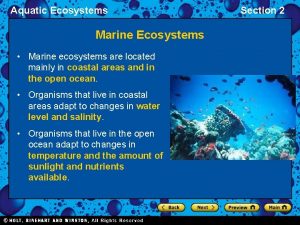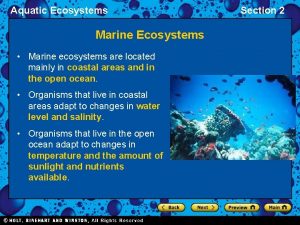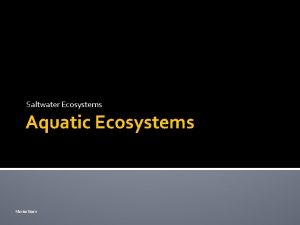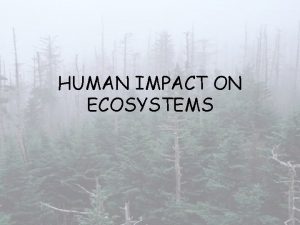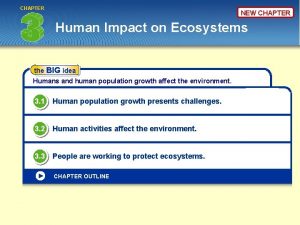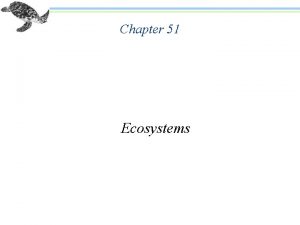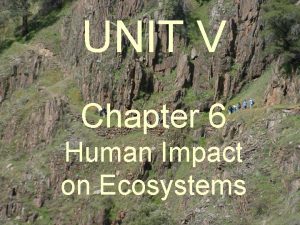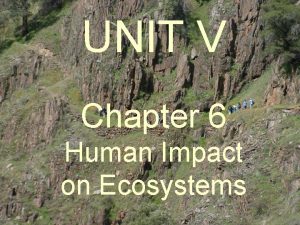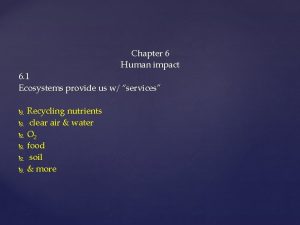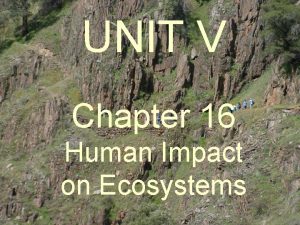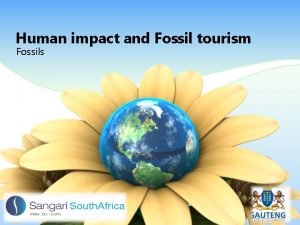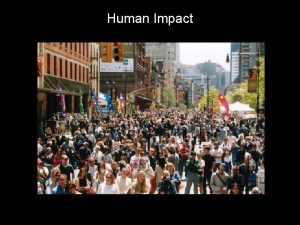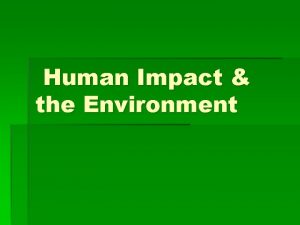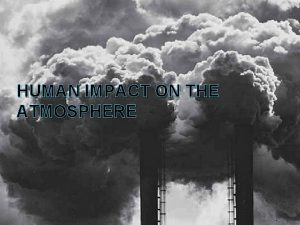Chapter 16 Human Impact on Ecosystems 16 1































- Slides: 31

Chapter 16 Human Impact on Ecosystems

16. 1 Objectives �Summarize the current state and effects of human population growth. �Explain the importance of effective resource management.

Human population �Earth’s carrying capacity is unknown

Two technological advancements that have contributed to population growth: �Gas-powered farm equipment �Medical advances (lower infant mortality rates)

Types of Resources �Nonrenewable: resources that are used faster than they are formed �Ex. Oil and coal


Types of Resources �Renewable: resources that cannot be used up or that replenish themselves over time �Ex. Wind and solar energy, plants and animals

Sustainable Use �Using resources in a way so that they are available for future generations

Ecological footprint �The amount of land needed to support a person �Land must produce and maintain enough food, water, shelter, energy and waste

Ecological footprint �Size depends on: �Amount and efficiency of resource use and amount and toxicity of waste produced

On the back of notes: �Currently, water is considered a renewable resource. Explain how water could become a nonrenewable resource. �Why is our ecological footprint related to an area of land?

Biodiversity �Brainstorm with your partner: �What are some of the products we get from living organisms? �Try to come up with at least 10 items

Threats to Biodiversity �Human activity can reduce biodiversity by: 1. Altering habitats 2. Hunting to extinction 3. Pollution 4. Introducing new species to an area

Altering habitats �As humans destroy habitats, species die out �Can lead to extinction: �Disappearance of species �Endangered species: in danger of becoming extinct http: //www. earthsendangered. com/continent. asp? gr=&v iew=&ID=9


Habitat Fragmentation �Splits ecosystems into pieces

16. 2 Objectives �Describe the sources, types, and effects of air pollution. �Explain how air pollution contributes to acid rain.

Pollution �Toxic compounds released to environment �Ex. DDT – pesticide �Nonbiodegradable

DDT (dichlorodiphenyltrichloroethane) �DDT is a pesticide that is sprayed onto crops �It drains into rivers and streams �Important properties of DDT: �Nonbiodegradable (cannot be broken down) �Will be stored in plants and animals that take it in �A plant may only store a low quantity of DDT �Herbivores will eat many plants, and store all the DDT from each plant in their tissues �Carnivores will eat those herbivores and store all the DDT from the herbivores in their tissues

Make a prediction… �Based on the information on DDT, what trophic level (primary, secondary, tertiary, etc) will be most affected by DDT? �Why? ? ?

Biological Magnification �Process where concentrations of a harmful substance increase in orgs. at higher trophic levels


Invasive Species �Plants and animals transported around the world �Can reproduce rapidly because they lack parasites and predators that control their population �Drive out native species

�Nutria: Human activity can reduce biodiversity by introducing foreign species to new environments. Native to South America, nutrias have become pests in coastal areas of the southeastern United States. These furry rodents eat water plants that protect fragile shorelines from erosion. This destroys the habitats of species native to those ecosystems.

Article – Zebra Mussells �Read the article �Answer the questions with your partner

Conservation �Wise management of natural resources �Protect single species �Protect entire ecosystems – biodiversity “hot spots” �Ensures that natural habitats and interactions of species are preserved


Section 16. 4 Charting a Course for the Future

Objectives �Describe two types of global change that are of concern to biologists.

Ozone Layer �Layer high in the atmosphere where ozone (O 3) is concentrated �Protects Earth from harmful radiation �Has been damaged by CFCs found in: �Aerosol sprays �Coolants (fridge, AC) �CFCs now banned

Global Warming �Increase in the average temp of biosphere �Caused by burning of fossil fuels �Adds CO 2 to atmosphere �Traps heat �May lead to rise in sea level and coastal flooding �What does this mean for Florida?
 Chapter 16: human impact on ecosystems answer key
Chapter 16: human impact on ecosystems answer key Chapter 16 human impact on ecosystems
Chapter 16 human impact on ecosystems Human impact on terrestrial ecosystems
Human impact on terrestrial ecosystems Human impact on freshwater ecosystems
Human impact on freshwater ecosystems Tornado impact to ecosystem
Tornado impact to ecosystem Chapter 27 human impact on earth resources
Chapter 27 human impact on earth resources Aquatic areas
Aquatic areas Chapter 4 lesson 2 energy flow in ecosystems
Chapter 4 lesson 2 energy flow in ecosystems Chapter 4 ecosystems and communities
Chapter 4 ecosystems and communities Chapter 6 biomes and aquatic ecosystems
Chapter 6 biomes and aquatic ecosystems 3 aquatic biomes
3 aquatic biomes Chapter 55 ecosystems and restoration ecology
Chapter 55 ecosystems and restoration ecology Chapter 42 ecosystems and energy
Chapter 42 ecosystems and energy Chapter 3 lesson 3 biomes and aquatic ecosystems
Chapter 3 lesson 3 biomes and aquatic ecosystems Limestone ridges built by tiny animals
Limestone ridges built by tiny animals Energy in ecosystems lesson 3 answer key
Energy in ecosystems lesson 3 answer key Chapter 7 aquatic ecosystems test answers
Chapter 7 aquatic ecosystems test answers Chapter 5 how ecosystems work study guide
Chapter 5 how ecosystems work study guide Chapter 55 ecosystems and restoration ecology
Chapter 55 ecosystems and restoration ecology Section 1: ecosystems: everything is connected
Section 1: ecosystems: everything is connected Chapter 14 interactions in ecosystems
Chapter 14 interactions in ecosystems Parasitism examples
Parasitism examples Human movement science impact factor
Human movement science impact factor Schlerophylls
Schlerophylls Human impact on lithosphere
Human impact on lithosphere Human impact on agriculture
Human impact on agriculture Carbon cycle human impact
Carbon cycle human impact Map of desert biomes
Map of desert biomes Human impact on the tundra
Human impact on the tundra Human impact on beaches
Human impact on beaches Human impact on groundwater
Human impact on groundwater Human impact on oceans
Human impact on oceans
